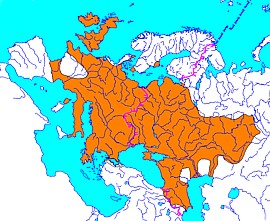|
 SCIENTIFIC
NAME: Pipistrellus nathusii Keyserling, Blasius, 1839 SCIENTIFIC
NAME: Pipistrellus nathusii Keyserling, Blasius, 1839
COMMON NAMES: Nathusius's pipistrelle
SYNONYMS: unicolor Fatio, 1905.
DIMENSIONS: Body mass 5-12 g, head and body length 46-58 mm, tail
length 30-44 mm, forearm length 33-37 mm, wingspan 23-25 cm.
DESCRIPTION: Small bat of a "typical" pipistrelle-like appearance.
Outer upper incisor only slightly sorter than inner one. Upper small
premolar slightly intruded from the tooth row and almost entirely
visible in lateral view. Only the most proximal part of the tail
membrane is covered with fur. The thumb is relatively long, usually
longer than 6 mm. The fur is thick, hairs of medium length, with
dark bases. Pelage color on the back varies from pale brown to dark-brown.
Underparts are more light-colored, grayish-pale.
DISTRIBUTION: From Southern and Central Europe (including Great
Britain) to the Kama river, south-western foothills of the Ural
mountains, Caucasus and the Middle East.
NATURAL HISTORY: Distributed throughout the mixed and broad-leafed
forest and forest-steppe zones, preferring forest edges, light and
disturbed forests. Often inhabits villages and human settlements.
Day roosts are situated in buildings, hollow trees and other crevice-like
shelters; this species frequently roosts together with other bat
species. Emergence from the dayroost starts in early twilight. A
typical aerial forager, preying on various small insects; flight
paths proceed at medium altitudes along forest edges, river banks,
over water-meadows, clearings etc., frequently in agricultural landscapes
and even cities. Foraging flight is relatively fast and maneuverable.
Echolocation calls are of middle to high intensity, a steep to shallow
FM sweep from ca. 70 to 38 kHz, with maximum energy around 35-40
kHz. Near the north-eastern limits of its distribution area it is
a seasonally migrant species, covering distances up to 1900 km.
Hibernacula are situated in hollow trees, buildings and underground
shelters. Copulation takes place after the end of lactation, and
is usually accompanied by characteristic lek-behavior, however,
it also occurs during hibernation. Mating colonies composed of a
male and a small temporary 'harem' of females are often situated
in tree hollows or under bridges. Births take place from the end
of May untill beginning of June. There are usually two newborns
per litter. Lactation lasts ca. 45 days. Nursing colonies contain
from several tens to several hundreds of individuals; males usually
live separately during this preiod. Estimated longevity is about
5-10 years.
STATUS: Widespread and common species. IUCN: "LR: lc".
|






